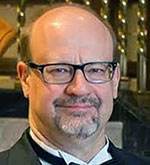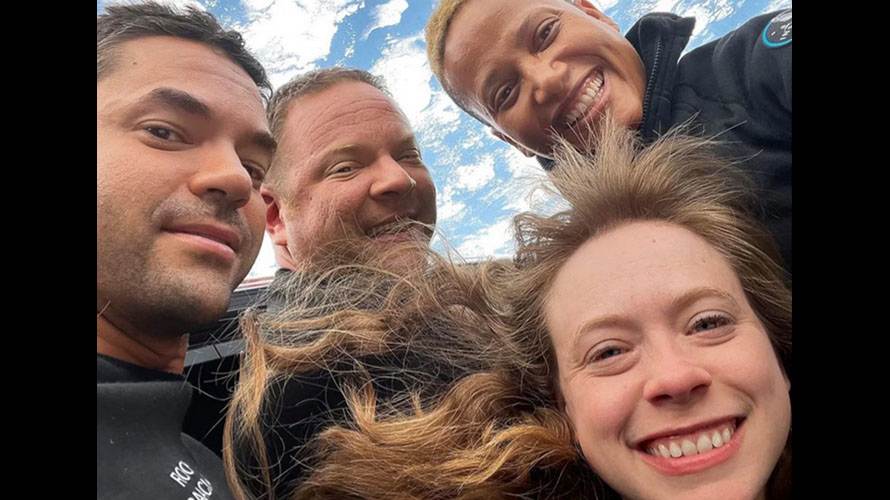
© by Dale Skran, NSS Chief Operating Officer
Image: Inspiration4 crew, courtesy Inspiration4
I can’t believe I am finally writing this, but 2021 was the year that space tourism “rebooted” big time. The first epoch of space tourism started on April 28, 2001, with the 8-day flight of American Dennis Tito to the ISS on a Russian Soyuz. This epoch ended with the September 30th, 2009 12-day flight of Canadian Guy Lalberte to the ISS, again on a Russian Soyuz. All of these flights were organized by Space Adventures. The second epoch of space tourism roared to life in 2021. I am going to cover the flights in descending order of “coolness” and achievement, at least to my view!
Inspiration 4/SpaceX
You can’t say that Inspiration4 was the first “orbital” tourist flight—see above—but it was the first orbital flight of the 2nd epoch of space tourism. With a crew of Americans that included Jared Isaacman, Sian Proctor, Hayley Arceneaux, and Christopher Sembroski, this flight featured:
- A big tie-in to fund raising for St. Jude’s Hospital, where Hayley works as a physician assistant.
- A capsule that was, in reality, doing all the flying, although pilot Sian Proctor could have taken over if needed.
- An altitude of 364 miles, the highest since STS-103 in 1999, and well above the ISS at 254 miles.
- Instead of a docking port, the Dragon 2 capsule sported a plexiglass domed observation window.
- A single technical issue involving the toilet.
- Coverage by a series of documentaries on Netflix.
- Hayley showing that being is space is a ton of fun if you don’t get space sick, which she apparently did not.
- Big success all around.
The Russians
The Russians returned to the space tourist business, again working with Space Adventures, to fly Japanese fashion billionaire Yusaku Maezawa and his production assistant Yozo Hirano to the ISS for 12 days on a Soyuz capsule starting on December 8th. You may have head of Yusaku before—he is planning on flying a SpaceX Starship around the Moon—but it appears he wanted to get some spaceflight experience in first.
Blue Origin
The Blue Origin New Shepard made three sub-orbital but over the Karman line tourist flights in 2021:
- July 20: Jeff Bezos himself joined his brother Mark Bezos, Oliver Daemen, and Wally Funk in a 10-minute flight above the Texas desert. Wally Funk is best known as one of the Mercury 13, a group of women that trained by NASA to fly in space but were never given the opportunity. At 82, Funk is the oldest woman to have flown to space. This was the third flight of New Shepard 4, also known as RSS First Step.
- October 13: William Shatner joined Chris Boshuizen, Audrey Powers, and Glen de Vries for another 10-minutes sub-orbital flight. You may recall that this Shatner fellow had some association with a TV show and a fictional spaceship. The big news was Shatner’s ebullient and eloquent speech subsequent to the landing regarding how tiny and fragile Earth seemed when viewed from space. At age 90, Shatner became the oldest man to fly in space, eclipsing the record set by John Glenn at age 77 on the Space Shuttle. This was the fourth flight of New Shepard 4, and the second crewed flight.
- December 11: For the first time there were six crew: Lane Bess, Cameron Bess, Evan Dick, Laura Shepard Churchley, Michael Strahan, and Dylan Taylor. Laura Shepard Churchley, the eldest daughter of Alan Shepard (the first American in space), and Michael Strahan, a former pro football player and television host, were nonpaying guests. Lane Bess and Cameron Bess are the first father-son pair to go into space together.
In addition to the three passenger flying launches just listed, Blue flew the New Shepard 4 twice to certify it to carry crew, and launched the New Shepard 3 for the 8th time on August 25 with 18 commercial payloads and a NASA lunar landing technology demonstration installed on the outside of the capsule. This bought Blue Origin to a record six New Shepard flights in one year, beating the previous record of four set in 2016.
Blue Origin gets high marks for creating a reliable hydro-lox sub-orbital rocket that spews clean water as exhaust, putting to rest fears that space tourism will pollute the Earth and exacerbate climate change. A tip of the hat to Jeff Bezos for “eating his own dogfood” and going on the first flight.
Virgin Galactic
Reaching an altitude of 86km, SpaceShipTwo fell a bit short of the 100km Karmen line, but Richard Branson won bragging rights over Bezos by flying his own sub-orbital tourist rocket July 11, 2021, beating Bezos to the punch by a few days, along with pilots Mackay and Masucci and passengers Sirisha Bandia, Colin Bennett, and Beth Moses.
Unfortunately for Branson, the flight veered a bit off course, leading to some after-flight drama about whether FAA protocols were violated. Also, instead of moving briskly on to regular commercial flights, the SpaceShipTwo and the carrier aircraft were wheeled back to the factory for repair work, not to fly again in 2021. And by comparison to the clean-burning New Shepard, the hybrid engine of Space Ship Two is less than stellar.
Conclusion
2021 was a really big year for space tourism, although clearly just the start of a new age for both orbital and sub-orbital tourism. Big questions remain:
- Will customers prefer the “Bezos rocket ride” or the “Branson space plane”?
- Can either Blue Origin or Virgin Galactic maintain a regular flight cadence in 2022?
- Just how big is the market for sub-orbital space tourism?
- Will the availability of much cooler orbital flights, whether to the ISS or not, overwhelm the sub-orbital companies?
- Just how big is the market for orbital space tourism?
- Will the many critics of space tourism impact the financial prospects of the companies involved?
- Will the government decide to extend the current “Learning Period” that delays full-bore FAA regulation of space tourism until after 2023?
- Will there be a major accident in 2022 that impacts the space tourism industry?
The above questions are giving a lot of people sweaty palms right now, but take a moment to bask in the signal achievements of space tourism in 2021. Derided by the ill-informed as “joy rides for the rich,” space tourism holds out the promise of good paying jobs on Earth and profits that over time lead to both lower costs to orbit and infrastructure in space to support tourism, helping to enable the exploration, development, and settlement of space. So, three cheers for space tourism in 2021, and fingers crossed for a great 2022!!!



















